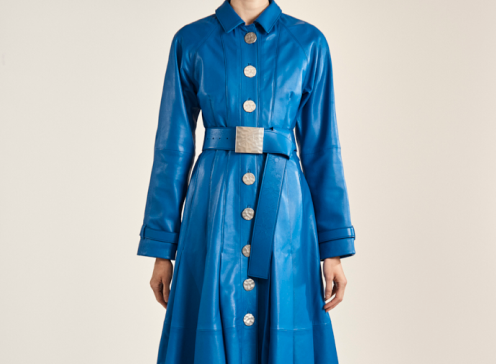The backlash against “fast fashion” has been underway for a while now. Environmentally savvy shoppers are increasingly conscious of the implications of fast fashion on landfills, labor and general waste that sees some brands burning unused stock. But from fast fashion to high-end luxury apparel and everything in between, a lesser-known practice continues to do lasting damage: the environmental impact of textile finishing––and in turn, its impact on our health.
Textile finishing is the process of treating a textile to give it any number of qualities, such as moisture wicking, softness, stain resistance and durability. It is one of the most polluting facets of one of the most polluting industries, with 25 percent of global chemical output stemming from textiles alone––and the chemicals used are often far from benign. The softness of your yoga pants can be credited to siloxanes: synthetic compounds that build up in the environment and harm aquatic life. Your shirt is wrinkle-free thanks to formaldehyde, a known carcinogen that can trigger allergic reactions and contact dermatitis in people with sensitive skin. And that water-repellent jacket? Courtesy of perfluorinated chemicals, which can bioaccumulate in the body and cause liver cancer, reproductive disruption and increased mortality in animals.
At Evolved By Nature, our work in apparel––and the textile industry more broadly––is focused on replacing these harmful finishing chemicals with something cleaner but equally high-performing: Activated Silk. Made from pure, natural protein that’s been liquified, it’s biocompatible, biodegradable in the environment and non-GMO. It replaces traditional finishing chemicals on everything from T-shirts to car seats and bed linens, and we’re partnering with a range of brands to make their apparel and accessories healthier and more sustainable.
Local Production, Global Hazards
Given that approximately 35 percent of the world’s textiles are produced in China, it might be easy to mistake industrial concerns for localized issues. But even if that were true, the textile pollution hazards to the area are staggering enough to necessitate change. Textile production is a significant contributor to China’s water contamination problem––and with up to 70 percent of the nation’s rivers, lakes, and reservoirs affected by pollution, a quarter of the Chinese population lacks access to clean drinking water.
It’s also a health risk that intersects with industrial labor concerns: Cancer is considered an occupational hazard among textile workers. Eventually, the clothes those workers handle wind up on the bodies of the fashion-forward around the world. Sometimes, the chemicals on those clothes have noticeable effects like skin irritation. But another cost of those chemicals shows up when they’re off our bodies. When we wash our clothes, we rinse away the chemicals that went into making them. That water finds its way into local waterways: our drinking water, water that supports aquatic life and water that nourishes the crops we eat.
Increasing Regulation
While the conscientious impulse may be to hold businesses accountable for their contribution to industrial pollution, a lack of supply chain transparency often leaves fashion brands in the dark about the chemicals used to make their products. Regulation helps––and in 2006, the European Union introduced the world’s most comprehensive regulatory legislation through its Registration, Evaluation, Authorisation and Restriction of Chemicals (REACH) program, which aims to foster improved transparency between manufacturers, importers and customers.
While some critics note that progress has been slow, with only a fraction of the 100,000 chemicals in use fully evaluated by authorities, the European Chemicals Agency expects to have all known substances of very high concern (SVHCs) registered in its Candidate List by 2020. Companies that wish to continue using these chemicals must apply for prior authorization and outline their plans to switch to safer alternatives. Several non-EU countries have adopted similar regulations, and China recently introduced an environmental protection tax to monitor and limit the amount of pollutant discharge generated by businesses, including textile companies.
Building and Managing Better Chemicals
A number of independent resources are now available for businesses seeking to make responsible chemical choices. The ZDHC Foundation’s Roadmap to Zero program enables environmentally conscious fashion brands to work together to adopt better chemical management practices, and nonprofit organizations such as GreenScreen are working to empower companies and suppliers to identify and replace hazardous chemicals with safer alternatives.
But for lasting change to happen, fashion brands need cleaner options from the start––and that’s where we come in. With a diverse portfolio of green, high-performance chemicals, Activated Silk is the world’s first broad-scale alternative to petroleum-based textile finishers. It’s price-competitive with conventional finishing chemicals, doesn’t disrupt existing manufacturing processes and can be used at scale, so it’s easy for companies to make the switch. From luxury fashion to performance apparel, we’re working to eliminate the need for toxic chemistry and evolve the way clothing is made––for the better.
